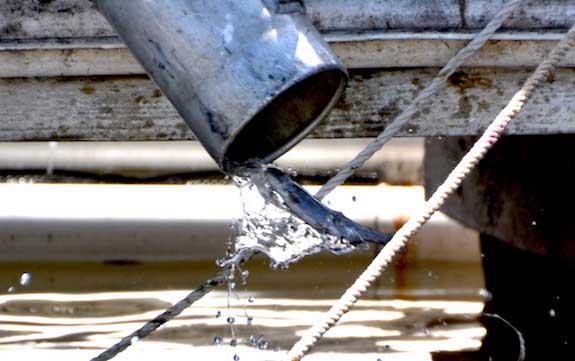DEC plans to reduce salmon stocking by 20% this year

Photos by Tom Rivers: A small steelhead is headed for one of the pens at Oak Orchard River in Carlton in this photo from April 8, 2019, when the DEC delivered 100,000 fish to the Oak Orchard, including 10,000 steelhead and 90,200 Chinook salmon. Charter boat captains and other volunteers have been raising fish in pens in the Oak Orchard River since 1998.
The state Department of Environmental Conservation said it will reduce salmon stocking by 20 percent this year to help protect the alewife population, which is a primary prey fish for salmon in Lake Ontario.
“In response to concerns over ongoing declines in Lake Ontario’s adult alewife population, DEC must reduce Chinook salmon and lake trout stocking further to provide adult alewife additional relief from predation,” the DEC states on its website.
Lake-wide salmon and trout stocking will still exceed 3.6 million fish by DEC and the Ontario Ministry of Natural Resources and Forestry.

A fisherman walks on west side pier at the Oak Orchard Harbor in this photo from May 3, 2015.
“Given favorable wind and water temperature patterns, anglers should expect continued, excellent fishing in 2020,” the DEC said. “Failure to reduce stocking levels would serve to extend the severity and duration of low adult alewife abundance, with greater potential impacts to the sportfishery.”
DEC is planning to stock 1,161,568 chinook yearlings in 2020, 601,600 lake trout yearling equivalents, 755,700 rainbow trout spring yearlings, 556,755 brown trout spring yearlings and 240,000 Atlantic salmon spring yearlings.
Dec officials will discuss the stocking strategy during a March 18 online public meeting. That day the DEC will also release the stocking locations and fish for those sites.
“DEC continues to apply the best available science to maintain the world-class status of Lake Ontario’s fisheries, which attract anglers from around the globe,” said DEC Commissioner Basil Seggos. “These changes to our Chinook salmon stocking strategy will enhance survival of stocked salmon and improve angling opportunities.”
DEC’s stocking site allocations of salmon and trout are decades old and largely proportioned by shoreline miles within DEC’s administrative regions bordering Lake Ontario. This proportional approach does not take into consideration fish movement studies, the benefits of pen rearing, and other factors that affect the success of the stocking program, including angler preferences, fishing effort, and geographic and seasonal differences in fish distribution.
DEC is currently working with the Lake Ontario Fisheries Management Focus Group, a panel of 16 anglers representing open lake and tributary fisheries, to modify trout and salmon stocking allocations to optimize the benefits of stocked fish to the overall sportfishery.
In 2020, DEC will concentrate Chinook salmon stocking at fewer sites to enhance post-stocking survival and improve open lake fisheries overall. This strategy will also enhance New York State’s late-summer staging fishery and existing tributary fisheries in key locations.
The online meeting will be held at 6:30 p.m. on March 18. Participants can use the following link to join the meeting: WebEx Meeting. Participants are directed to use the meeting number 647 538 274, password: Chinook2020.
Upon joining the meeting, participants will be prompted to connect to audio using their computer. To connect to audio via phone, use the following call-in information: toll free number 1-844-633-8697 and access code: 641 790 213.
Stocking information presented at the meeting will be posted on the DEC’s website the day of the meeting. Questions regarding this meeting can be directed to Steve LaPan, Great Lakes Fisheries Section Head, at 315-654-2147 or fwfishlo@dec.ny.gov.





































































